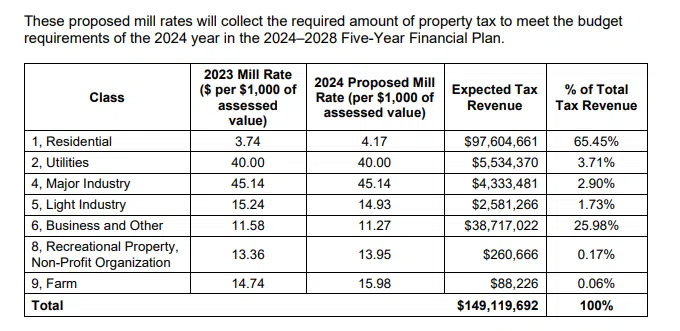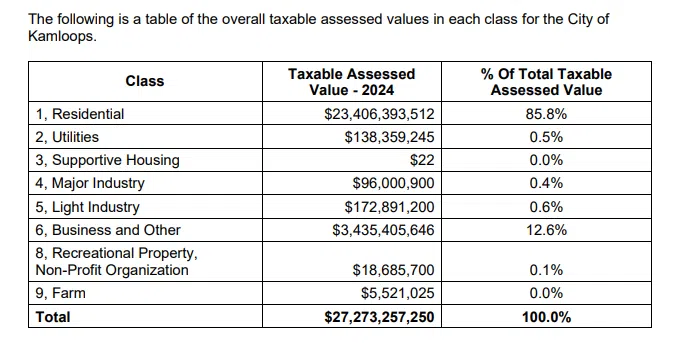
The City of Kamloops is moving ahead with a 9.55 per cent property tax increase in 2024.
While the City whittled down its provisional budget, and deferred some supplemental items, staff say “contracted or economic impacts” are to blame for the majority of this year’s increase, with the supplemental budget adding just 0.1 per cent to the tax bill.
City Councillors have begun the process to approve the tax rate bylaw, which will set the mill rates for the various property classes in Kamloops.
“When we look at the proposed mill rates compared from 2023 to 2024, that 9.55 per cent increase is in addition to the growth that we’ve seen in some of the organizations,” Taxation Manager Norman Thompson said Tuesday.
“As you can see from the different classes, we end up with $149 million as per the financial plan.”

Photo via City of Kamloops
Thompson says the setting of the tax rates is the final step in the City’s annual budget planning process.
“We compare the current and prior year assessment rolls to determine growth and then we adjust the prior year rates based on current year assessed values, including the market growth,” Thompson added.
“So when we look at the overall assessed value in each class, residential is 85.8 per cent of our total assessment and business and other Class 6 is 12.6 per cent. They take the bulk of our assessments, over 98 per cent.”
 Kamloops Councillors will finalize the tax rate bylaw at their next meeting on May 14, one day before the bylaw has to be submitted to the Provincial Government.
Kamloops Councillors will finalize the tax rate bylaw at their next meeting on May 14, one day before the bylaw has to be submitted to the Provincial Government.
City staff will then mail out tax notices to property owners with those taxes due by July 2.
City to review major industry taxation policy
The City of Kamloops will also be revising its policy GGL-27 that covered Major Industry Tax Rates.
The goal of that policy as to gradually reduce the Class 4 tax rate – which applies to major industry like lumber and pulp mills – to the provincial average. It stipulated that the maximum taxation revenue collected from Class 4 properties should not exceed $6.2 million.
“If we applied the policy as it stands, it would reduce the Class 4 tax rate below the provincial average,” Thompson said, in his report to Council.
“The cities used for comparisons since 2016 need to be reviewed along with the policy, and Administration should bring back recommendations to Council on a new policy for Class 4.”
Coucillor Mike O’Reilly says he was hoping to see a significant amount of work done to update that policy, noting whatever decision is reached “will have impacts.”
“GGL 27 came out of the community, a local working group I believe it was. They came up with this policy and now that its at the end of its life which I’m very grateful that it did last this long,” O’Reilly said.
“We need to spend a lot of time on this, and I suggest it should start at the economic health committee because there is going to be a lot of heavy lifting on this. It will have impacts one way or the other.
City Council is expected to make a decision on what that policy could look like by the end of this year.
“GGL-27 was a policy crafted to try and bring the industry tax rate to the provincial average,” Thompson said. “As that goal has been achieved, I think the next iteration of this is going to be looking at what do we want our tax rate to look at?
“In all likelihood this will be a recrafting of a new council based policy as we have accomplished the goal. Now how do we establish the right parameters for this to be something that is sustained longer term.”













